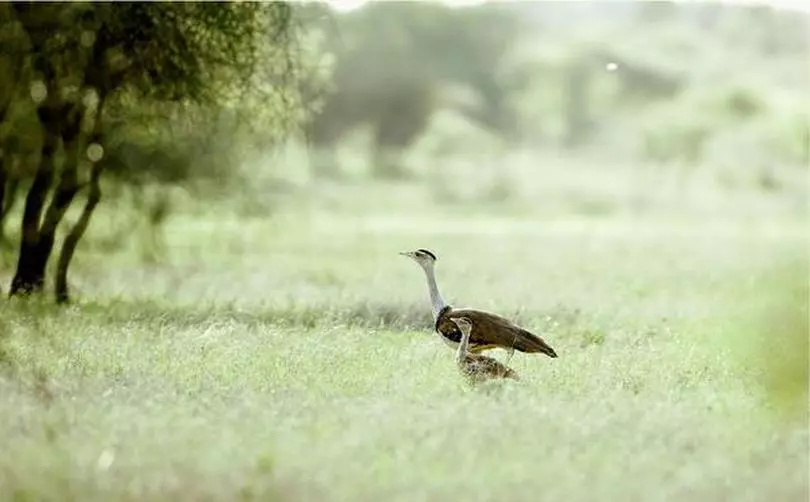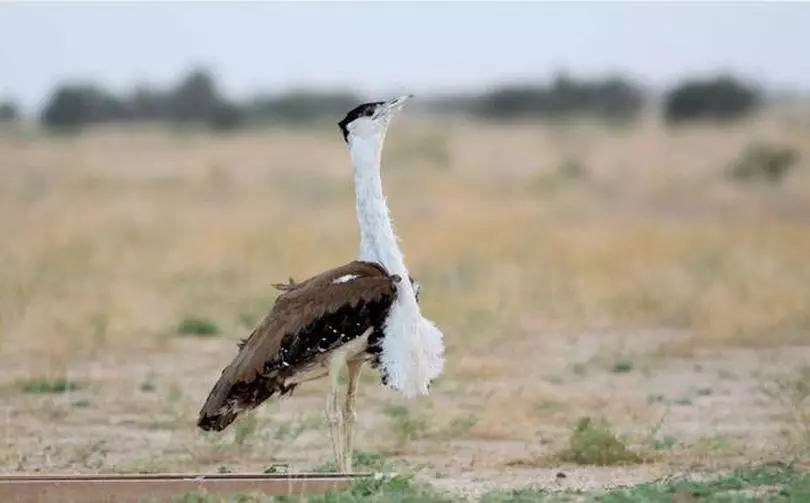The aerial view of the tiny desert-city of Jaisalmer is dotted with hundreds of windmills. Rising above the desert sands, these structures are connected to each other by thin wires. This renewable energy source is beloved of environmentalists, but, in an unfortunate twist, the windmills have been detrimental to the keystone species of the Thar desert. Their taut wires are turning into traps for the Great Indian Bustard (GIB), an endangered species that was once a close contender for the national bird status.
A mere 150 are left in this arid habitat. Found mainly in Sudasari, Miajlar, Bandhara and Ramdeora — all of which are part of a designated 3,162-sqkm Desert National Park (DNP) — the GIB shares space with another 107 species of birds and 21 species of mammals.

No man’s land:The GIB population found at Jaisalmer’s Desert National Park is extremely shy and sensitive to human presence. Photo: Anoop K R
Listed under Schedule I of the International Union for Conservation of Nature, the GIB is accorded the highest protection under the Wildlife Protection Act of 1972. A state-level action plan called Project Great Indian Bustard to restore the bird’s population was jointly hammered out by the Rajasthan government, Wildlife Institute of India (WII), and CAMPA (Compensatory Afforestation Fund Management and Planning Authority) in 2014. A hatchery at Nokh, in Jaisalmer, and a breeding centre near Sorsan, Kota, are planned by the State government. Apart from the exclosures (areas from which unwanted animals are excluded) in the DNP, a satellite exclosure at the Indian army’s firing range in Pokhran has around 51 birds.
“The plan is to breed them at the centre for three-four generations, and then start releasing them into the wild. The bird has a lifespan of 15-20 years in captivity. The female lays only one egg per year (two in rare cases), that too only if it deems the ecological conditions fit for the chick’s survival. While the bird has a ‘relatively long life, its population growth is slow,” says Bipin CM, project associate, WII, who is researching as part of the ongoing GIB conservation efforts.
Human intrusion
The bird’s population in the Thar desert is extremely shy and sensitive to human presence, especially during the breeding season from March to October. The mating rituals are elaborate — the male perches on a higher ground and fills its gular pouch with air to utter a deep guttural sound, which can be heard several kilometres across the desert. Among the heaviest flying birds, the male GIB can grow up to 10-12 kg, and the female 5-8 kg. They feed on local plants such as the peelu, also known as meswak(Salvadora persica) and the bushy sewan grass, a local, drought-resistant variety that can survive up to 20 years.
In this fragile environment, human interference has had unintended effects. The Indira Gandhi National Canal, which took decades to build and brought about a green revolution in Rajasthan, has also threatened the desert ecology in ways that weren’t anticipated. The increased water levels have made cultivation and habitation possible in desert regions. Settlements of herders (dhanis) began jowar cultivation and the populations of sheep, cow and goats have increased to unsustainable levels. Says state forest official Man Singh, “It is difficult to man the exclosures [for GIB] at all times of the day and night, and prevent villagers from entering the fenced areas to graze their cattle.”
In the twilight hour, I accompany the team as they tag GPS locations of previously found egg clutches. The lights of the Thar jeep pick out a herd of cows, numbering close to a hundred, waiting to pass through a breach in the fence. Forest guards are alerted and they rush to the spot. The Eco Task Force is a contingent of army officers, serving and retired, who patrol these fences. They wait for the villagers to arrive and take back their cattle.
The support of the people living within and near the DNP is crucial to saving the GIB from extinction, says Ashok Kumar Mahariya, Deputy Conservator of Forests, Indian Forest Service, who’s the Director of DNP. The villages and dhaniswithin the DNP are angry at what they see as the pitfalls of living in an eco-sensitive area. “They can’t sell off their land easily, and feel that the bird hampers their lifestyle,” says Singh.
The more than 1,000 villages within the DNP that earlier followed a traditional pastoral life, have increased their farm production, which puts pressure on the land. While the area within the exclosures is chock-full of the nutritional sewan grass, it’s barren outside the fence.
Forest officials find it challenging to get the villagers engaged in the conservation effort. Among their suggestions to the State government is a policy change to declare the villages within the sanctuary as islands, to free them from the enforced restrictions of an eco-sensitive zone, or relocating them to another place. Both suggestions will directly affect the livelihoods of hundreds of villagers.
Pushed to the margins
Sorsan was chosen as a breeding centre under Project Bustard despite being relatively far from the hatchery in Jaisalmer. The incubated eggs can be transported from the arid environment of the hatchery to the greener breeding centre, says Bipin. “Whenever a conservation breeding centre is set up, best possible environmental conditions and disease transmission from the wild to the captive population is of great concern. The place needs a 24x7 assured power supply, road links, water and other logistics. There should be optimal breeding conditions to ensure success. Finally, conservation breeding isn’t a temporary project, but a lifelong one. If people are dedicating their lives to make the godawan (GIB) thrive, the environment of the centre needs to be more habitable for the support staff as well,” he says.
The biggest threat to the bird currently are the windmills, hunting across the border when they fly into Pakistan, as well as the danger from ground-dwelling predators such as feral dogs and wild pigs. In response to a petition filed by Mahendra Borawat and 11 other villagers, the National Green Tribunal had in 2016 banned the installation of windmills and directed the State government to declare the DNP an eco-sensitive zone. Mahariya says the forest department does try hard to prevent windmills from coming up, but claims that the WII has presented them with a way out. “We are asking the windmill companies to install bird diverters every five metres, to prevent the loss of life. We’ve installed some imported ones on a trial basis, but a local company has been asked to manufacture them as well. The second solution is to re-install the wires underground, although this would be costly and can take time. The third solution is to relocate the windmills away from here.” Radio tags are another measure to control poaching and hunting of the bird, pending State approval.
The GIB was not always restricted to the arid grasslands of the Thar. Even 50 years ago, they were found across the country.

Dotting the margins: The GIB, once found in grasslands across the country, has been marginalised to specific pockets along the nation’s several borders. Photo: Anoop K R
“Right now, they are found in three pockets on the borders of five states — in Rajasthan (Jaisalmer district, close to the Pakistan border), the grasslands of Kutch in Gujarat; and the tri-junction of Maharashtra (Solapur), Karnataka (Bellary and Haveri) and Andhra Pradesh (Kurnool) states,” says Bipin. He believes that while the birds preferred greener pastures, they may have been pushed to the borders as these are the last to be colonised by human population. “Bustards are literally being pushed to the borders of this country... This isn’t what you would call their ideal environment, and this is a typical pattern in the extinction of a species. The last cheetah that was found was also in a semi-deciduous forest, though, historically, they have preferred a greener habitat,” Bipin says.

